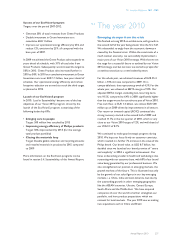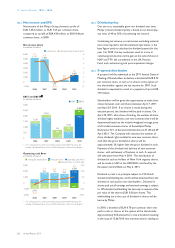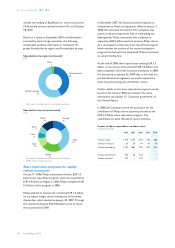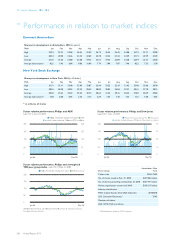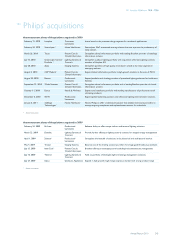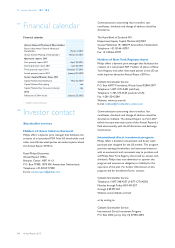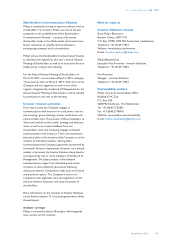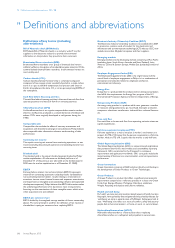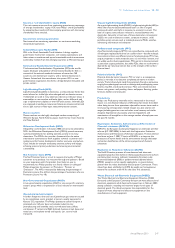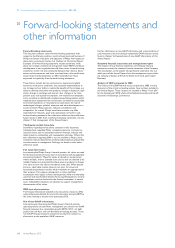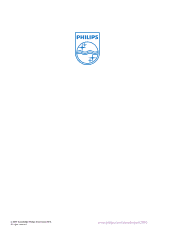Philips 2010 Annual Report Download - page 247
Download and view the complete annual report
Please find page 247 of the 2010 Philips annual report below. You can navigate through the pages in the report by either clicking on the pages listed below, or by using the keyword search tool below to find specific information within the annual report.19 Definitions and abbreviations 19 - 19
Annual Report 2010 247
Income as % of shareholders’ equity (ROE)
This ratio measures income from continuing operations as percentage
of average shareholders’ equity. ROE rates Philips’ overall profitability
by evaluating how much profit the company generates with the money
shareholders have invested.
Income from continuing operations
Net income from continuing operations, or net income excluding
discontinued operations.
Initiatief Duurzame Handel (IDH)
IDH is the Dutch Sustainable Trade Initiative. It brings together
government, frontrunner companies, civil society organizations and
labor unions to accelerate and up-scale sustainable trade in mainstream
commodity markets from the emerging countries to Western Europe.
International Standardization Organization (ISO)
The International Standardization Organization (ISO)is the world’s
largest developer and publisher of International Standards. ISO is a
network of the national standards institutes of more than 160
countries, one member per country, with a Central Secretariat in
Geneva, Switzerland, that coordinates the system. ISO is a non-
governmental organization that forms a bridge between the public and
private sectors.
Light-Emitting Diode (LED)
Light-Emitting Diode (LED), in electronics, a semiconductor device that
emits infrared or visible light when charged with an electric current.
Visible LEDs are used in many electronic devices as indicator lamps, in
automobiles as rear-window and brake lights, and on billboards and
signs as alphanumeric displays or even full-color posters. Infrared LEDs
are employed in autofocus cameras and television remote controls and
also as light sources in fiber-optic telecommunication systems.
Mature markets
Mature markets are the highly developed markets comprising of
Western Europe, North America, Japan, South Korea, Israel, Australia
and New Zealand.
Millennium Development Goals (MDG)
Adopted by world leaders in the year 2000 and set to be achieved by
2015, the Millennium Development Goals (MDGs) provide concrete,
numerical benchmarks for tackling extreme poverty in its many
dimensions. The MDGs also provide a framework for the entire
international community to work together towards a common end –
making sure that human development reaches everyone, everywhere.
Goals include for example eradicating extreme poverty and hunger,
achieving universal primary education and ensuring environmental
sustainability.
Net Promoter Score (NPS)
The Net Promoter Score is a tool to measure the loyalty of Philips’
customers to its products. It is measured through one question: “Based
on your experience with this product, how likely are you to
recommend your Philips product to a friend, relative or colleague?”
Philips categorizes the answers as ‘Promoters’, ‘Passives’ or
‘Detractors’. The NPS is measured by deducting the percentage of
Detractors (score 0 to 6) from the percentage of customers who are
Promoters (score 9 to 10).
Non-Governmental Organization (NGO)
A non-governmental organization (NGO) is any non-profit, voluntary
citizens’ group which is organized on a local, national or international
level.
Operational carbon footprint
A carbon footprint is the total set of greenhouse gas emissions caused
by an organization, event, product or person; usually expressed in
kilotons CO2-equivalent. The Philips operational carbon footprint is
calculated on a half-year basis and includes industrial sites
(manufacturing and assembly sites), non-industrial sites (offices,
warehouses, IT centers and R&D facilities), business travel (lease and
rental cars, and airplane travel) and logistics (air, sea and road
transport).
Organic Light-Emitting Diode (OLED)
An organic light emitting diode (OLED) is a light-emitting diode (LED) in
which the emissive electroluminescent layer is a film of organic
compounds which emit light in response to an electric current. This
layer of organic semiconductor material is situated between two
electrodes. Generally, at least one of these electrodes is transparent.
OLEDs are used in television screens, computer monitors, small,
portable system screens such as mobile phones and PDAs, watches,
advertising, information and indication.
Perfluorinated compounds (PFC)
A perfluorinated compound (PFC) is an organofluorine compound with
all hydrogens replaced by fluorine on a carbon chain—but the molecule
also contains at least one different atom or functional group. PFCs have
unique properties to make materials stain, oil, and water resistant, and
are widely used in diverse applications. PFCs persist in the environment
as persistent organic pollutants, but unlike PCBs, they are not known to
degrade by any natural processes due to the strength of the carbon–
fluorine bond.
Polyvinyl chloride (PVC)
Polyvinyl chloride, better known as PVC or vinyl, is an inexpensive
plastic so versatile it has become completely pervasive in modern
society. The list of products made from polyvinyl chloride is exhaustive,
ranging from phonograph records to drainage and potable piping, water
bottles, cling film, credit cards and toys. More uses include window
frames, rain gutters, wall paneling, doors, wallpapers, flooring, garden
furniture, binders and even pens.
Productivity
Philips uses Productivity internally and as mentioned in this annual
report as a non-financial indicator of efficiency that relates the added
value, being income from operations adjusted for certain items such as
restructuring and acquisition-related charges etc. plus salaries and
wages (including pension costs and other social security and similar
charges), depreciation of property, plant and equipment, and
amortization of intangibles, to the average number of employees over
the past 12 months.
Registration, Evaluation, Authorization and Restriction of
Chemical substances (REACH)
REACH is the European Community Regulation on chemicals and their
safe use (EC 1907/2006). It deals with the Registration, Evaluation,
Authorisation and Restriction of Chemical substances. The law entered
into force on June 1, 2007. The aim of REACH is to improve the
protection of human health and the environment through the better
and earlier identification of the intrinsic properties of chemical
substances.
Regulation on Hazardous Substances (RoHS)
The RoHS Directive prevents all new electrical and electronic
equipment placed on the market in the European Economic Area from
containing lead, mercury, cadmium, hexavalent chromium, poly-
brominated biphenyls (PBB) or polybrominated diphenyl ethers
(PBDE), except in certain specific applications, in concentrations
greater than the values decided by the European Commission. These
values have been established as 0.01% by weight per homogeneous
material for cadmium and 0.1% for the other five substances.
Waste Electrical and Electronic Equipment (WEEE)
The Waste Electrical and Electronic Equipment Directive (WEEE
Directive) is the European Community directive on waste electrical and
electronic equipment which became European Law in February 2003,
setting collection, recycling and recovery targets for all types of
electrical goods. The directive imposes the responsibility for the
disposal of waste electrical and electronic equipment on the
manufacturers of such equipment.


